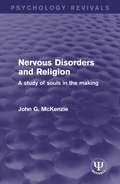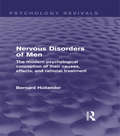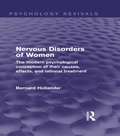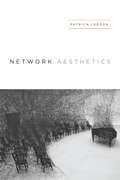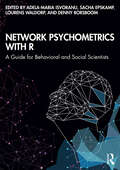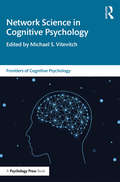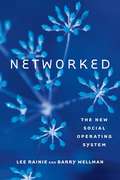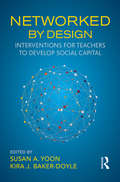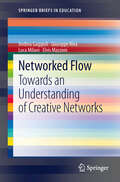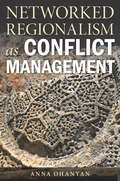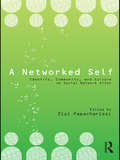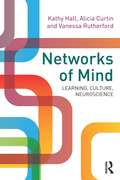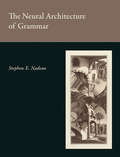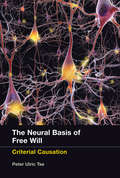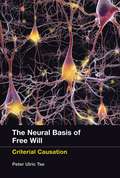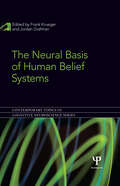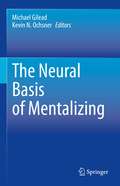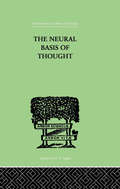- Table View
- List View
Nervous Disorders and Religion: A Study of Souls in the Making (Psychology Revivals)
by John G. McKenzieOriginally published in 1951, this title is a study in developmental psychology with special reference to the effect of various types of religion on mental health and religious experience. With instinct as a ‘disappearing category’ in the psychology of human nature, a new approach to the realization of a harmonious interior life has been made using a doctrine of biological and personality needs as a starting point. Human nature is acquired and is not a static datum. The interior conflicts, the development of conscience and the origin of guilt feeling, the morbid complexes and the character-trends resulting from these conflicts with their sense of guilt are all studied. A long chapter on the various methods of mental healing through the doctrines of psycho-somatic medicine, with a new approach to Spiritual Healing in particular, prepares the way for the final chapter on the types of religion which originate or accentuate psychological conflicts, and the kind of religion which leads to a basic sense of security and harmonious personality. The illustrations are nearly all taken from Dr McKenzie’s own thirty years’ experience of dealing with neurotic disorders. This volume contains the substance (greatly expanded) of the Tate lectures delivered in Manchester College, Oxford, in 1947, and repeated at the St Andrews Summer School of Theology in1948 and at Iona Community.
Nervous Disorders of Men: The Modern Psychological Conception of their Causes, Effects, and Rational Treatment (Psychology Revivals)
by Bernard HollanderBorn in Vienna in 1864, Bernard Hollander was a London-based psychiatrist. He is best known for being one of the main proponents of phrenology. This title, originally published in 1916, looks at ‘the numerous nervous illnesses of men, in which the mental factor plays a large part, and which are known as functional disorders, to distinguish them from organic diseases’. He looks at the role of psychotherapy as an emerging treatment for these disorders. There is also a companion volume which looks at the Nervous Disorders of Women.
Nervous Disorders of Women: The Modern Psychological Conception of their Causes, Effects and Rational Treatment (Psychology Revivals)
by Bernard HollanderBorn in Vienna in 1864, Bernard Hollander was a London-based psychiatrist. He is best known for being one of the main proponents of phrenology. This title, originally published in 1916, looks at ‘the numerous nervous illnesses of women, in which the mental factor plays a large part, and which are known as functional disorders, as distinguished from organic diseases’. He looks at the role of psychotherapy as an emerging treatment for these disorders. There is also a companion volume which looks at the Nervous Disorders of Men.
The Nets of Modernism: Henry James, Virginia Woolf, James Joyce, and Sigmund Freud
by Maud Ellmann"One of the finest literary critics of her generation, Maud Ellmann synthesises her work on modernism, psychoanalysis and Irish literature in this important new book. In sinuous readings of Henry James, James Joyce and Virginia Woolf, she examines the interconnections between developing technological networks in modernity and the structures of modernist fiction, linking both to Freudian psychoanalysis. The Nets of Modernism examines the significance of images of bodily violation and exchange - scar, bite, wound, and their psychic equivalents - showing how these images correspond to 'vampirism' and related obsessions in early twentieth-century culture. Subtle, original and a pleasure to read, this book offers a new perspective on the inter-implications of Freudian psychoanalysis and Anglophone modernism that will influence the field for years to come"--
Network Aesthetics
by Patrick JagodaThe term "network" is now applied to everything from the Internet to terrorist-cell systems. But the word's ubiquity has also made it a cliché, a concept at once recognizable yet hard to explain. Network Aesthetics, in exploring how popular culture mediates our experience with interconnected life, reveals the network's role as a way for people to construct and manage their world--and their view of themselves. Each chapter considers how popular media and artistic forms make sense of decentralized network metaphors and infrastructures. Patrick Jagoda first examines narratives from the 1990s and 2000s, including the novel Underworld, the film Syriana, and the television series The Wire, all of which play with network forms to promote reflection on domestic crisis and imperial decline in contemporary America. Jagoda then looks at digital media that are interactive, nonlinear, and dependent on connected audiences to show how recent approaches, such as those in the videogame Journey, open up space for participatory and improvisational thought. Contributing to fields as diverse as literary criticism, digital studies, media theory, and American studies, Network Aesthetics brilliantly demonstrates that, in today's world, networks are something that can not only be known, but also felt, inhabited, and, crucially, transformed.
Network Psychometrics with R: A Guide for Behavioral and Social Scientists
by Denny Borsboom Adela-Maria Isvoranu Sacha Epskamp Lourens J. WaldorpA systematic, innovative introduction to the field of network analysis, Network Psychometrics with R: A Guide for Behavioral and Social Scientists provides a comprehensive overview of and guide to both the theoretical foundations of network psychometrics as well as modelling techniques developed from this perspective. Written by pioneers in the field, this textbook showcases cutting-edge methods in an easily accessible format, accompanied by problem sets and code. After working through this book, readers will be able to understand the theoretical foundations behind network modelling, infer network topology, and estimate network parameters from different sources of data. This book features an introduction on the statistical programming language R that guides readers on how to analyse network structures and their stability using R. While Network Psychometrics with R is written in the context of social and behavioral science, the methods introduced in this book are widely applicable to data sets from related fields of study. Additionally, while the text is written in a non-technical manner, technical content is highlighted in textboxes for the interested reader. Network Psychometrics with R is ideal for instructors and students of undergraduate and graduate level courses and workshops in the field of network psychometrics as well as established researchers looking to master new methods.
Network Science in Cognitive Psychology (Frontiers of Cognitive Psychology)
by Michael S. VitevitchThis volume provides an integrative review of the emerging and increasing use of network science techniques in cognitive psychology, first developed in mathematics, computer science, sociology, and physics. The first resource on network science for cognitive psychologists in a growing international market, Vitevitch and a team of expert contributors provide a comprehensive and accessible overview of this cutting-edge topic. This innovative guide draws on the three traditional pillars of cognitive psychological research–experimental, computational, and neuroscientific–and incorporates the latest findings from neuroimaging. The network perspective is applied to the fundamental domains of cognitive psychology including memory, language, problem-solving, and learning, as well as creativity and human intelligence, highlighting the insights to be gained through applying network science to a wide range of approaches and topics in cognitive psychology Network Science in Cognitive Psychology will be essential reading for all upper-level cognitive psychology students, psychological researchers interested in using network science in their work, and network scientists interested in investigating questions related to cognition. It will also be useful for early career researchers and students in methodology and related courses.
Networked
by Lee Rainie Barry WellmanDaily life is connected life, its rhythms driven by endless email pings and responses, the chimes and beeps of continually arriving text messages, tweets and retweets, Facebook updates, pictures and videos to post and discuss. Our perpetual connectedness gives us endless opportunities to be part of the give-and-take of networking. Some worry that this new environment makes us isolated and lonely. But in Networked, Lee Rainie and Barry Wellman show how the large, loosely knit social circles of networked individuals expand opportunities for learning, problem solving, decision making, and personal interaction. The new social operating system of "networked individualism" liberates us from the restrictions of tightly knit groups; it also requires us to develop networking skills and strategies, work on maintaining ties, and balance multiple overlapping networks. Rainie and Wellman outline the "triple revolution" that has brought on this transformation: the rise of social networking, the capacity of the Internet to empower individuals, and the always-on connectivity of mobile devices. Drawing on extensive evidence, they examine how the move to networked individualism has expanded personal relationships beyond households and neighborhoods; transformed work into less hierarchical, more team-driven enterprises; encouraged individuals to create and share content; and changed the way people obtain information. Rainie and Wellman guide us through the challenges and opportunities of living in the evolving world of networked individuals.
Networked By Design: Interventions for Teachers to Develop Social Capital
by Susan A. Yoon Kira J. Baker-DoyleNetworked by Design brings together work from leading international scholars in the learning sciences that applies social network theory to teachers’ social interactions and relationships. The volume examines the direct and indirect relationships and communities that teachers navigate, as well as the models, plans, and other interventions that allow them to exercise control over these networks. Each chapter draws from case studies or latitudinal research to investigate a different intervention and its outcomes. By presenting research conducted in a variety of scales and contexts, this book offers scholars, future teachers, and leaders diverse insights into how interventions in social capital and social networks can create impactful, meaningful teaching and learning.
Networked Flow
by Luca Milani Giuseppe Riva Elvis Mazzoni Andrea GaggioliIdentifying 'networked flow' as the key driver of networked creativity, this new volume in the Springer Briefs series deploys concepts from a range of sub-disciplines in psychology to suggest ways of optimizing the innovative potential of creative networks. In their analysis of how to support these networks, the contributing authors apply expertise in experimental, social, cultural and educational psychology. They show how developing a creative network requires the establishment of an optimal group experience in which individual intentions inform and guide collective goals. The volume represents a three-fold achievement. It develops a ground-breaking new perspective on group creativity: the notion of 'networked flow' as a bridging concept linking the neuropsychological, psychological and social levels of the creative process. In addition, the authors set out a six-stage model that provides researchers with a methodological framework (also by referring to the social network analysis) for studying the creativity traditionally associated with interpersonal contexts. Finally, the book includes perceptive analysis of the novel possibilities opened up by second-generation internet technologies, particularly in social networking, that seem destined to develop and sustain online creativity. As a wide-ranging exposition of a new direction in theoretical psychology that is laden with exciting possibilities, this volume will inform and inspire professionals, scholars and students alike.
Networked Regionalism as Conflict Management
by Anna OhanyanMost regions of the world are plagued by conflicts that are made insoluble by a confluence of complex threads from history, geography, politics, and culture. These "frozen conflicts" defy conflict management interventions by both internal and external agents and institutions. Worse, they constantly threaten to extend beyond their local geographies, as in the terrorist bombings in Boston by ethnic Chechens, or to escalate from skirmishes to full-scale war, as in Nagorno-Karabakh. Consequently, such conflicts cry out for alternative approaches to the classic, state-focused, and sovereignty-based conflict management models that are practiced in traditional diplomacy--which most often produce rather short-term, ad hoc, fragmented interventions and outcomes. Drawing upon the cases of the South Caucasus, the Western Balkans, Central America, South East Asia, and Northern Ireland, Networked Regionalism as Conflict Management offers a theoretical and practical solution to this impasse by arguing for regional collective interventions that involve a long-term reengineering of existing conflict management infrastructure on the ground. Such approaches have been attracting the attention of scholars and practitioners alike yet, thus far, these concepts have rarely involved more than simple prescriptions for regional cooperation between grassroots actors and traditional diplomacy. Specifically, says Anna Ohanyan, only the cultivation and establishment of regional peace systems can provide an effective path toward conflict management in these standoffs in such intractably divided regions.
A Networked Self: Identity, Community, and Culture on Social Network Sites
by Zizi PapacharissiA Networked Self examines self presentation and social connection in the digital age. This collection brings together new work on online social networks by leading scholars from a variety of disciplines. The focus of the volume rests on the construction of the self, and what happens to self-identity when it is presented through networks of social connections in new media environments. The volume is structured around the core themes of identity, community, and culture - the central themes of social network sites. Contributors address theory, research, and practical implications of many aspects of online social networks including self-presentation, behavioral norms, patterns and routines, social impact, privacy, class/gender/race divides, taste cultures online, uses of social networking sites within organizations, activism, civic engagement and political impact.
Networking-Kompetenz im Job: Psychologisches Kommunikationswissen für Berufseinstieg und Karriere (essentials)
by Katja Mierke Dominic-Nicolas Gansen-AmmannDie Autoren geben in diesem essential unter R#65533;ckgriff auf evolutions- und wirtschaftspsychologische Modelle einen #65533;berblick #65533;ber Befunde der Karriereforschung, Facetten sozialer Fertigkeit und deren Bedeutung f#65533;r Networking und Besch#65533;ftigungsf#65533;higkeit. Sie fassen Erkenntnisse sozialpsychologischer Studien zur Relevanz pers#65533;nlicher Ziele und zur aktiven Steuerung eigener Verhaltensmuster praxisnah zusammen und machen sie durch #65533;bungen karrierebezogen nutzbar. Auf Basis eines Phasenmodells geben sie Impulse zu Aufbau, Pflege und Nutzung des eigenen Netzwerks und zeigen, wie sich positive Kommunikation auf den Einzelnen sowie auf den Erfolg von Arbeitsteams auswirkt. Das essential schlie#65533;en die Autoren mit weiteren Anregungen zum individuellen Praxistransfer.
Networking Works! The WetFeet Insider Guide to Networking
by WetFeetWetFeet has earned a strong reputation among college graduates and career professionals for its series of highly credible, no-holds-barred Insider Guides. This one is on networking, a valuable skill in any industry.
Networks of Mind: Learning, Culture, Neuroscience
by Kathy Hall Alicia Curtin Vanessa RutherfordThis ground breaking book is unique in bringing together two perspectives on learning - sociocultural theory and neuroscience. Drawing on both perspectives, it foregrounds important developments in our understanding of what learning is, where and how learning occurs and what we can do to understand learning as an everyday process. Leading experts from both disciplines demonstrate how sociocultural ideas (such as the relevance of experience, opportunity to learn, environment, personal histories, meaning, participation, memory, and feelings of belonging) align with and reflect upon new understandings emerging from neuroscience concerning plasticity and neural networks. Among the themes critically examined are the following: Mind and brain Culture Ability and talent Success and failure Memory Language Emotion Aimed at and accessible to a broad audience and drawing on both schools of thought, Networks of Mind employs case studies, vignettes and real life examples to demonstrate that, though the language of sociocultural theory and that of neuroscience appear very different, ultimately the concepts of both perspectives align and converge around some key ideas. The book shows where both perspectives overlap, collide and diverge in their assumptions and understanding of fundamental aspects of human flourishing. It shows how neuroscience confirms some of the key messages already well established by sociocultural theory, specifically the importance of opportunity to learn. It also argues that the ascendency of neuroscience may result in the marginalization of sociocultural science, though the latter, it argues, has enormous explanatory power for understanding and promoting learning, and for understanding how learning is afforded and constrained.
Netzwerke und soziale Innovationen: Lösungsansätze für gesellschaftliche Herausforderungen? (Schriften zur Gruppen- und Organisationsdynamik #12)
by Christian Neugebauer Sebastian Pawel Helena Biritz Ewald E. KrainzIm vorliegenden Sammelband Netzwerke und Soziale Innovationen wird der Frage nachgegangen, welchen Beitrag Netzwerke bei der Entstehung und Entwicklung von sozialen Innovationen leisten können und wie dies zu Veränderungen in der Gesellschaft führt. In einem Mix aus theoretischen und reflexiven Beiträgen als auch der Darstellung von spannenden Initiativen und Projekten – von den InitiatorInnen selbst anschaulich geschildert –, wird die Thematik praxisorientiert aufgearbeitet. Sowohl PraktikerInnen als auch WissenschaftlicherInnen erhalten wertvolle Hinweise für die Organisation und Entwicklung sozialer Innovationen.
Neue Medien und kindliche Entwicklung: Ein Überblick für Therapeuten, Pädagogen und Pädiater (essentials)
by Martina Zemp Guy BodenmannDieses Essential zeigt, welche Konsequenzen die Nutzung von Fernseher, Computer und Internet für Kinder und Jugendliche hat - und was Fachleute Eltern raten können. Aus wissenschaftlicher Perspektive wird deutlich, dass die Nutzung von gewaltbetonten Medien ein Prädiktor für aggressives Verhalten bei Heranwachsenden ist, neuen Medien ein Suchtpotenzial innewohnt und exzessive Mediennutzung den kindlichen Schulleistungen abträglich sein kann. Entscheidend sind jedoch die Häufigkeit der Nutzung und der Medieninhalt. Vor diesem Hintergrund stehen Eltern in der Pflicht, klare Strukturen bezüglich Form, Inhalt und Dauer der Mediennutzung ihrer Kinder durchzusetzen.
Neue Stimmen in der psychosozialen Forschung
by Stephen FroshDie psychosozialen Studien im Vereinigten Königreich sind ein vielfältiger Arbeitsbereich, der sich durch Innovation in Theorie und empirischer Forschung auszeichnet. Die außerordentliche Lebendigkeit dieses Bereichs zeigt sich in diesem Buch, das die Forschungsarbeiten der Abteilung für psychosoziale Studien an der Birkbeck University of London, UK, vorstellt und drei zentrale Bereiche der Disziplin beleuchtet: Psychoanalyse, Ethik und Reflexivität sowie Widerstand. Das Buch befasst sich auf psychosoziale Weise mit einer Vielzahl von Themen, von der Sozialkritik der Psychoanalyse über postkoloniale und Queer-Theorie bis hin zu Studien über psychische Gesundheit und Widerstand gegen Diskriminierung. Diese "New Voices in Psychosocial Studies" bieten eine kohärente und doch weitreichende Darstellung der Forschung, die in einem "Dialekt" des neuen Terrains der psychosozialen Studien stattgefunden hat, und ein Agenda-setzendes Manifest für einige der Arten von Arbeit, die die fortgesetzte Kreativität der psychosozialen Studien in der nächsten Generation sicherstellen könnten. Dieses Buch zeigt die kontinuierliche Entwicklung der psychosozialen Studien als innovative, kritische Kraft und wird sowohl neue als auch etablierte Forscher aus allen Bereichen inspirieren, die ihren transdisziplinären Ansatz beeinflussen, einschließlich: kritische Psychologie und radikale Soziologie, feministische, queere und postkoloniale Theorie, kritische Anthropologie und Ethnographie und Phänomenologie.
The Neural Architecture of Grammar (The\mit Press Ser.)
by Stephen E. NadeauA comprehensive, neurally based theory of language function that draws on principles of neuroanatomy, cognitive psychology, cognitive neuropsychology, psycholinguistics, and parallel distributed processing.Linguists have mapped the topography of language behavior in many languages in intricate detail. To understand how the brain supports language function, however, we must take into account the principles and regularities of neural function. Mechanisms of neurolinguistic function cannot be inferred solely from observations of normal and impaired language. In The Neural Architecture of Grammar, Stephen Nadeau develops a neurologically plausible theory of grammatic function. He brings together principles of neuroanatomy, neurophysiology, and parallel distributed processing and draws on literature on language function from cognitive psychology, cognitive neuropsychology, psycholinguistics, and functional imaging to develop a comprehensive neurally based theory of language function. Nadeau reviews the aphasia literature, including cross-linguistic aphasia research, to test the model's ability to account for the findings of these empirical studies. Nadeau finds that the model readily accounts for a crucial finding in cross-linguistic studies—that the most powerful determinant of patterns of language breakdown in aphasia is the predisorder language spoken by the subject—and that it does so by conceptualizing grammatic function in terms of the statistical regularities of particular languages that are encoded in network connectivity. He shows that the model provides a surprisingly good account for many findings and offers solutions for a number of controversial problems. Moreover, aphasia studies provide the basis for elaborating the model in interesting and important ways.
The Neural Architecture of Grammar
by Stephen E. NadeauLinguists have mapped the topography of language behavior in many languages in intricate detail. To understand how the brain supports language function, however, we must take into account the principles and regularities of neural function. Mechanisms of neurolinguistic function cannot be inferred solely from observations of normal and impaired language. In The Neural Architecture of Grammar, Stephen Nadeau develops a neurologically plausible theory of grammatic function. He brings together principles of neuroanatomy, neurophysiology, and parallel distributed processing and draws on literature on language function from cognitive psychology, cognitive neuropsychology, psycholinguistics, and functional imaging to develop a comprehensive neurally based theory of language function. Nadeau reviews the aphasia literature, including cross-linguistic aphasia research, to test the model's ability to account for the findings of these empirical studies. Nadeau finds that the model readily accounts for a crucial finding in cross-linguistic studies--that the most powerful determinant of patterns of language breakdown in aphasia is the predisorder language spoken by the subject--and that it does so by conceptualizing grammatic function in terms of the statistical regularities of particular languages that are encoded in network connectivity. He shows that the model provides a surprisingly good account for many findings and offers solutions for a number of controversial problems. Moreover, aphasia studies provide the basis for elaborating the model in interesting and important ways.
The Neural Basis of Free Will: Criterial Causation
by Peter Ulric TseA neuroscientific perspective on the mind–body problem that focuses on how the brain actually accomplishes mental causation. The issues of mental causation, consciousness, and free will have vexed philosophers since Plato. In this book, Peter Tse examines these unresolved issues from a neuroscientific perspective. In contrast with philosophers who use logic rather than data to argue whether mental causation or consciousness can exist given unproven first assumptions, Tse proposes that we instead listen to what neurons have to say. Tse draws on exciting recent neuroscientific data concerning how informational causation is realized in physical causation at the level of NMDA receptors, synapses, dendrites, neurons, and neuronal circuits. He argues that a particular kind of strong free will and “downward” mental causation are realized in rapid synaptic plasticity. Such informational causation cannot change the physical basis of information realized in the present, but it can change the physical basis of information that may be realized in the immediate future. This gets around the standard argument against free will centered on the impossibility of self-causation. Tse explores the ways that mental causation and qualia might be realized in this kind of neuronal and associated information-processing architecture, and considers the psychological and philosophical implications of having such an architecture realized in our brains.
The Neural Basis of Free Will
by Peter Ulric TseThe issues of mental causation, consciousness, and free will have vexed philosophers since Plato. In this book, Peter Tse examines these unresolved issues from a neuroscientific perspective. In contrast with philosophers who use logic rather than data to argue whether mental causation or consciousness can exist given unproven first assumptions, Tse proposes that we instead listen to what neurons have to say. Because the brain must already embody a solution to the mind--body problem, why not focus on how the brain actually realizes mental causation? Tse draws on exciting recent neuroscientific data concerning how informational causation is realized in physical causation at the level of NMDA receptors, synapses, dendrites, neurons, and neuronal circuits. He argues that a particular kind of strong free will and "downward" mental causation are realized in rapid synaptic plasticity. Recent neurophysiological breakthroughs reveal that neurons function as criterial assessors of their inputs, which then change the criteria that will make other neurons fire in the future. Such informational causation cannot change the physical basis of information realized in the present, but it can change the physical basis of information that may be realized in the immediate future. This gets around the standard argument against free will centered on the impossibility of self-causation. Tse explores the ways that mental causation and qualia might be realized in this kind of neuronal and associated information-processing architecture, and considers the psychological and philosophical implications of having such an architecture realized in our brains.
The Neural Basis of Human Belief Systems (Contemporary Topics in Cognitive Neuroscience)
by Jordan Grafman Frank KruegerIs the everyday understanding of belief susceptible to scientific investigation? Belief is one of the most commonly used, yet unexplained terms in neuroscience. Beliefs can be seen as forms of mental representations and one of the building blocks of our conscious thoughts. This book provides an interdisciplinary overview of what we currently know about the neural basis of human belief systems, and how different belief systems are implemented in the human brain. The chapters in this volume explain how the neural correlates of beliefs mediate a range of explicit and implicit behaviours ranging from moral decision making, to the practice of religion. Drawing inferences from philosophy, psychology, psychiatry, religion, and cognitive neuroscience, the book has important implications for understanding how different belief systems are implemented in the human brain, and outlines the directions which research on the cognitive neuroscience of beliefs should take in the future. The Neural Basis of Human Belief Systems will be of great interest to researchers in the fields of psychology, philosophy, psychiatry, and cognitive neuroscience.
The Neural Basis of Mentalizing
by Michael Gilead Kevin N. OchsnerHumans have a unique ability to understand the beliefs, emotions, and intentions of others—a capacity often referred to as mentalizing. Much research in psychology and neuroscience has focused on delineating the mechanisms of mentalizing, and examining the role of mentalizing processes in other domains of cognitive and affective functioning. The purpose of the book is to provide a comprehensive overview of the current research on the mechanisms of mentalizing at the neural, algorithmic, and computational levels of analysis.The book includes contributions from prominent researchers in the field of social-cognitive and affective neuroscience, as well as from related disciplines (e.g., cognitive, social, developmental and clinical psychology, psychiatry, philosophy, primatology). The contributors review their latest research in order to compile an authoritative source of knowledge on the psychological and brain bases of the unique human capacity to think about the mental states of others. The intended audience is researchers and students in the fields of social-cognitive and affective neuroscience and related disciplines such as neuroeconomics, cognitive neuroscience, developmental neuroscience, social cognition, social psychology, developmental psychology, cognitive psychology, and affective science. Secondary audiences include researchers in decision science (economics, judgment and decision-making), philosophy of mind, and psychiatry.
The Neural Basis Of Thought: The Diaries Of Escher, Bodmer, May And De Gallois 1814-18
by Campion, George G & Elliot Smith, GraftonFirst Published in 1999. Routledge is an imprint of Taylor & Francis, an informa company.
